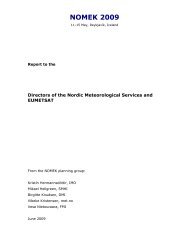International Symposium on Mitigative Measures against Snow ...
International Symposium on Mitigative Measures against Snow ...
International Symposium on Mitigative Measures against Snow ...
You also want an ePaper? Increase the reach of your titles
YUMPU automatically turns print PDFs into web optimized ePapers that Google loves.
<str<strong>on</strong>g>Internati<strong>on</strong>al</str<strong>on</strong>g> <str<strong>on</strong>g>Symposium</str<strong>on</strong>g> <strong>on</strong> <strong>Mitigative</strong> <strong>Measures</strong> <strong>against</strong> <strong>Snow</strong> Avalanches<br />
Egilsstaðir, Iceland, March 11–14, 2008<br />
Development, assessment and effect of a new avalanche braking<br />
system in the Mühlauer-Klamm, Innsbruck, Austria<br />
Manfred Pittracher<br />
Austrian Service for Torrent and Avalanche C<strong>on</strong>trol, Liebeneggstraße 11, A-6020 Innsbruck, AUSTRIA<br />
e-mail: manfred.pittracher (at) die-wildbach.at<br />
ABSTRACT<br />
North of Innsbruck the Mühlauer-Klamm–avalanche endangers Mühlau, a part of Innsbruck<br />
the capital of Tyrol. The starting z<strong>on</strong>e spreads over an area of 2.6 km² and leads to a gorgestyled<br />
avalanche track. The average inclinati<strong>on</strong> of the track is 15°. The run out close to the<br />
lower end of the gorge is densely settled. Six buildings are in the red z<strong>on</strong>e and 7 buildings in<br />
the yellow z<strong>on</strong>e of the hazard-map of Innsbruck. This situati<strong>on</strong> was not accepted by the<br />
authorities. So, a special protecti<strong>on</strong>-system was developed, which c<strong>on</strong>sists of 2 braking –<br />
structures to enhance the retarding effort of the gorge.<br />
The envir<strong>on</strong>mental c<strong>on</strong>diti<strong>on</strong>s of the catchment and the selecti<strong>on</strong>-procedure of the protecti<strong>on</strong><br />
measures with regard to ec<strong>on</strong>omical, ecological and technical c<strong>on</strong>diti<strong>on</strong>s, are described.<br />
Finally, the influence of the avalanche braking – system <strong>on</strong> land-use planning is presented.<br />
Since this protecti<strong>on</strong>-measure is unique, no experience about its effects exists. Therefore, in<br />
cooperati<strong>on</strong> between the federal service of avalanche and torrent c<strong>on</strong>trol (WLV) and the<br />
federal forest research centre (BFW), a study was carried out to verify the expected effect of<br />
the system. A numerical investigati<strong>on</strong> was c<strong>on</strong>ducted with SAMOS and ELBA avalanche<br />
simulati<strong>on</strong> models. In additi<strong>on</strong>, model tests in a water-tank will be performed.<br />
The decisi<strong>on</strong> procedure of the project and results of the numerical analysis are presented.<br />
1. INTRODUCTION<br />
The populati<strong>on</strong> have increased c<strong>on</strong>siderably in the Alps since 1950 especially in Innsbruck.<br />
The number of inhabitants has increased from 95.000 in the year 1950 to 150.000 in 2007<br />
(Grieser, 2007). The city of Innsbruck covers an area of 105 km², but <strong>on</strong>ly 35 % or 36 km² of<br />
this area is suitable for permanent settlement. Innsbruck have a populati<strong>on</strong> density of 3.830<br />
pers<strong>on</strong>s per km². More than half of the available area for settlement is already planned for<br />
c<strong>on</strong>structi<strong>on</strong>. In this situati<strong>on</strong> the price range of housing space lies between EUR 3.000 and<br />
EUR 4.000 per m². Because of the c<strong>on</strong>tinuous increasing populati<strong>on</strong> these prices are expected<br />
to grow further.<br />
During the last 50 years, the settlements have expanded into areas which are endangered by<br />
natural hazards like the Mühlauer-Klamm-avalanche. This avalanche endangers 41 people<br />
(Nolf, 2007) and therefore causes the biggest risk in Innsbruck. The resettlement of these<br />
pers<strong>on</strong>s to safe parts of the city is not a political opti<strong>on</strong>. No politician could stand the public<br />
storm caused by a drastic measure like that. So in the past, Innsbruck decided to evacuate the<br />
affected pers<strong>on</strong>s in hazardous periods. These evacuati<strong>on</strong>s are also extremely unpopular and<br />
have not always been accepted by some of the inhabitants. Therefore the municipal<br />
58 A new avalanche braking system in the Mühlauer-Klamm











